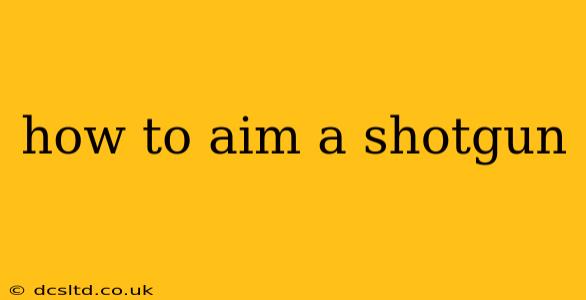Shotgunning is a unique shooting discipline that requires a different approach than aiming a rifle or pistol. Understanding the fundamentals of shotgun aiming is crucial for safe and effective shooting, whether you're hunting, participating in competitive shooting sports, or practicing for self-defense. This guide will break down the key aspects of shotgun aiming, addressing common questions and misconceptions.
What is the Best Way to Aim a Shotgun?
Unlike rifles, which utilize precise aiming down the sights, shotguns rely more on a technique called pointing or swinging. This is due to the shotgun's wide spread pattern of shot. Precise aiming is less critical than covering your target with the shot pattern. Effective shotgun aiming involves a combination of:
-
Proper Stance and Grip: A solid, balanced stance is paramount. Your feet should be shoulder-width apart, and your grip should be firm but not tense. This ensures stability and controlled movement.
-
Mount the Shotgun: Bring the shotgun to your shoulder smoothly, ensuring a proper cheek weld and a consistent sight picture. Avoid rushing this process.
-
Pointing, Not Aiming: Instead of focusing on precise aiming, focus on covering your target with the muzzle. Visualize a circle encompassing your target—that's where your shot will land.
-
Swinging through the Target: For moving targets, practice swinging the shotgun through the target, not at it. This ensures that the shot is released while the barrel is covering the target.
How Far Can You Accurately Aim a Shotgun?
The effective range of a shotgun varies greatly depending on the choke (the constriction at the end of the barrel), the type of ammunition, and the target. Generally speaking, you can expect accurate patterns (able to consistently hit a target) out to around 35-40 yards with birdshot. However, for self-defense or hunting larger game, slugs can offer significantly increased accuracy, extending the effective range. Beyond these ranges, shot patterns become increasingly dispersed and unreliable.
What Are the Different Types of Shotgun Sights?
Shotguns come with various sighting systems, including:
-
Bead Sights: These are the simplest form, a single bead located on the rib (the top of the barrel). They provide a basic reference point for aligning the shotgun with the target.
-
Rib Sights: The rib itself acts as a sight, allowing for a more intuitive aiming method. Some ribs feature a mid-rib bead for further assistance.
-
Ghost Ring Sights: These offer a clearer sight picture in low-light conditions.
-
Fiber Optic Sights: These bright sights are ideal for fast target acquisition.
The choice of sights depends largely on personal preference and shooting style. Many experienced shotgunners prefer the simplicity and intuitive nature of bead sights, especially for close-range shooting.
What is the Best Choke for Aiming a Shotgun?
The choke of your shotgun significantly impacts its shot pattern. Chokes narrow the barrel's opening, influencing the shot's dispersion.
-
Cylinder: Produces the widest pattern, best for very close-range targets.
-
Improved Cylinder: Slightly tighter than Cylinder.
-
Modified: A good all-around choice offering a balance between pattern density and range.
-
Full: Produces a very tight pattern, ideal for longer-range shots with minimal shot spread.
The optimal choke depends on the intended use and target distance. For most hunting and self-defense situations, a Modified or Improved Cylinder choke provides a good compromise between pattern density and range.
How Do I Practice Aiming a Shotgun Safely?
Safe shotgun handling is paramount. Always:
- Treat every firearm as if it were loaded.
- Keep your finger off the trigger until ready to shoot.
- Point the shotgun in a safe direction.
- Be sure of your target and what is beyond it.
- Use appropriate hearing and eye protection.
- Start with professional instruction. A qualified instructor can teach you proper techniques and safety procedures.
By understanding these fundamental principles, you can significantly improve your shotgun aiming skills and ensure safe and effective shooting. Remember, practice is key to mastering any shooting discipline. Consistent practice and professional guidance are invaluable for developing a proper technique and building confidence.
